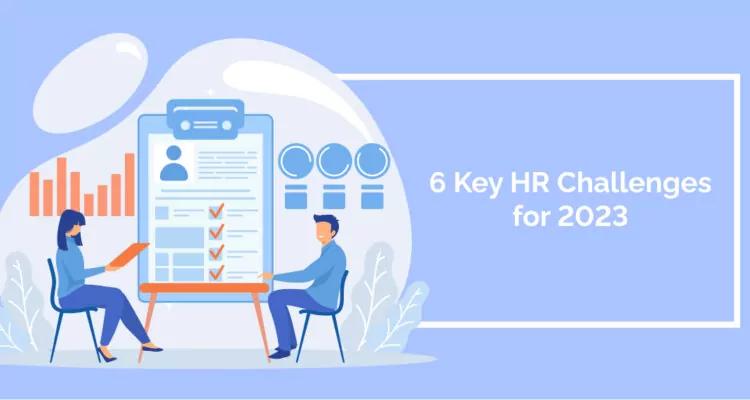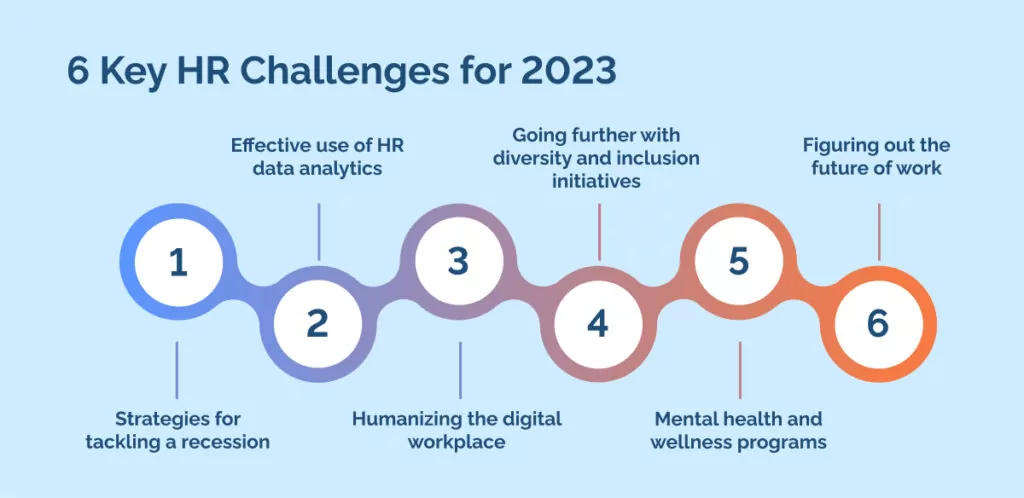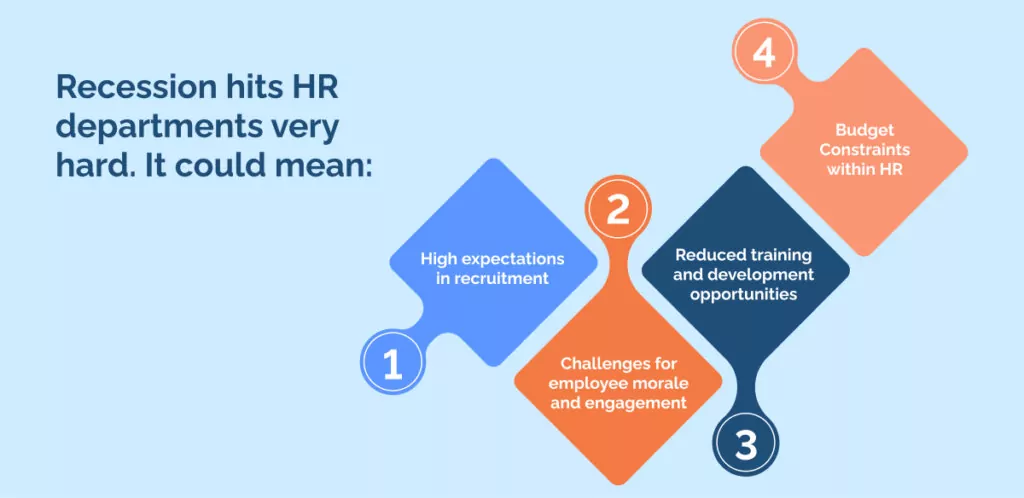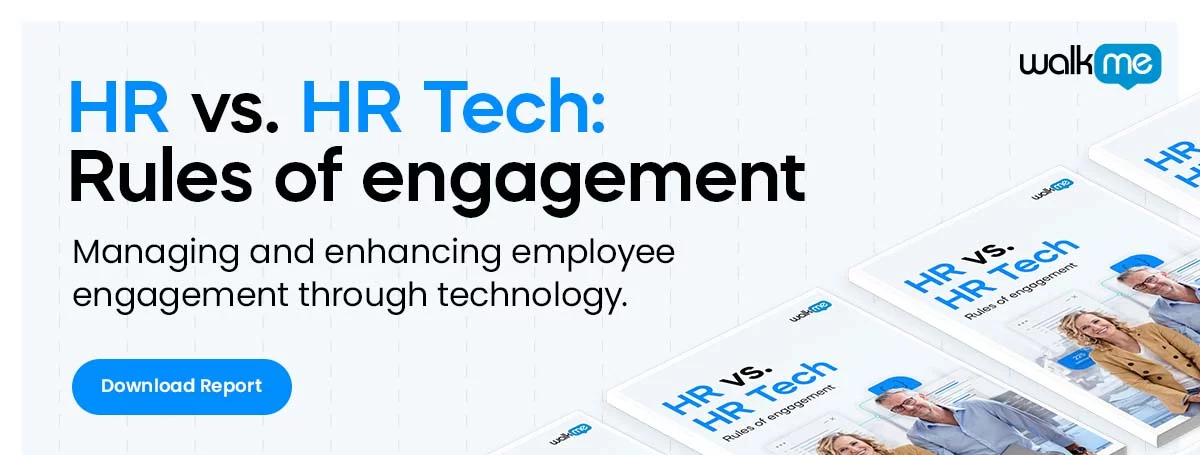
Recession. Inflation. Poverty crisis.
These factors can all feel remote from the work of HR teams. But the reality is that these global problems create new challenges every month. And the best companies will integrate them into their human resources strategy as quickly and effectively as possible.

We’ve looked at prominent thought leaders and HR professionals to develop a list of the six most important issues HR leaders face in 2023. In our view, those are:
- Strategies for tackling a recession
- Effective use of HR data analytics
- Humanizing the digital workplace
- Going further with diversity and inclusion initiatives
- Mental health and wellness programs
- Figuring out the future of work.
There are, of course, many other challenges. The final section will give a quick overview of some year-on-year HR challenges.
2023 is a difficult time. Professional people are introducing many innovative ideas, but business leaders are desperate to see the returns on their investments. So much so that the writer Eric Mosley called this “the year of ROI”!
Keep an eye on these challenges, and you can get those rewards from HR.
- Strategies for tackling recession
For many HR leaders, global recision is at the top of the list of challenges.
It’s making a dent in every industry. And for the foreseeable future, uncertainty will be a fact of life. It won’t be enough to sit and wait for this “rainy day” to end: we could have a lot more to come.

Recession hits HR departments very hard. It could mean:
- High expectations in recruitment. Recruiting and onboarding new employees is a costly procedure. Larger organizations will still need to hire.
- Challenges for employee morale and engagement. A recession can create an atmosphere of fear and uncertainty among employees who may worry about job security and the overall stability of the organization.
- Reduced training and development opportunities. HR may need to find cost-effective ways to provide essential employee training and foster a culture of continuous learning.
- Budget Constraints within HR. The HR department may experience budget cuts, limiting its capacity to carry out essential functions and implement new initiatives. So, HR may have fewer staff members to undertake innovative practices.
So, how do you tackle these problems?
- First, get the basics right. In tough times, you’ll need strong HR leaders, excellent communications with staff, and strong decision-making at every level. Of course, the choices won’t be easy. But when the world is uncertain, providing employees with the highest clarity you can achieve is vital.
- Be open to ideas. Will remote work for your company or other flexible work arrangements? Can you reduce employee turnover by raising salaries? Can you reduce costs by accelerating your digital transformation plans (or, indeed, by putting them on hold)?
- Don’t be “penny-wise and pound foolish.” HR departments must still invest in skilled professionals, employee compensation, and positive employee experience. When you’re looking to reduce operational costs, make genuinely efficient decisions in the long term.
In short, HR professionals should continue to do their best work.
Using data and HR Analytics
A couple of years ago, Oracle reported that many organizations are now finding ways to use HR analytics well. In their research, it turned out that two-thirds of businesses use HR analytics effectively.
That was great news: but data analysis does not stand still. In 2023, human resources teams should search hard to see the potential of HR analytics in their business. Three key areas for growth are sun hybrid and remote work, decision-making, and all-around innovation through digital transformation.
By the way – if you want to go deeper, check out our handy guide to HR analytics.
HR analytics and hybrid work
The pandemic proved that our “common sense” about office work was not so sensible. Some leaders are keen to roll back the freedoms their staff have enjoyed. After all, conventional wisdom says, “My grandparents never got to work at home, and it never hurt them!”
In 2023, companies shouldn’t rely on vague impressions to understand the impact of remote work: with HR analytics, they can gather the data that proves what works for them.
HR data analytics can provide a comprehensive view of employee productivity and engagement levels, identify potential challenges in remote team collaboration, and assess the effectiveness of communication tools and technologies. Additionally, it helps to track the impact of work models on employee well-being, work-life balance, and overall job satisfaction.
HR analytics for managerial Decision making
HR analytics influences managerial decision-making by providing data-driven insights and evidence-based recommendations. Through analyzing various HR metrics, such as employee performance, turnover rates, training effectiveness, and engagement levels, HR analytics enables managers to better understand their workforce’s dynamics and challenges.
These insights help them identify trends, anticipate potential issues, and make informed decisions to optimize team performance and productivity. HR analytics also aids in strategic workforce planning, talent acquisition, and succession planning, ensuring that managers have the right people with the right skills in the right positions.
Innovations in HR analytics and data analysis
If your company is feeling the effects of the recession, avoiding any big alterations in your working practices might be tempting. However, this might be the right time for a root-and-branch HR transformation.
HR digital transformation enables centralized data management, real-time data accessibility, and advanced analytics capabilities. With improved reporting and visualization, HR professionals can make informed decisions, enhance talent management, and implement data-driven recruitment and retention strategies. HR analytics supports diversity and inclusion initiatives, compliance, and risk management, fostering continuous improvement in the HR function and overall organizational performance.
Keeping humanity within the digital workplace

Humanization in the digital workplace is essential because digital workplaces can feel dehumanized due to reduced face-to-face interactions, isolation from constant technology use, and a focus on efficiency over empathy.
HR departments can help by promoting a culture of personal connections, encouraging virtual social events, emphasizing active listening, and supporting work-life balance. The benefits include increased employee satisfaction, enhanced collaboration, improved talent retention, reduced burnout, and overall organizational success.
Going further with diversity
Everyone knows that “diversity” is on the business agenda. So – why is this still a challenge for HR managers in 2023?
Diversity, equity, and inclusion programs are certainly common today. However, the goals of these programs are not always as ambitious as they should be. Some companies may promote diversity to improve their employer brand – but do as little as possible to change things for under-represented groups.
A HR department can promote diversity initiatives through inclusive recruitment practices, diversity training, and supporting diverse leadership development. Business-wide benefits include increased innovation, better decision-making, improved employee morale, enhanced creativity, a broader talent pool, and a stronger employer brand. Embracing diversity fosters a more inclusive and dynamic workplace, leading to higher productivity and a competitive edge in the market.
So, diversity and equity is not a new invention in 2023. But today, HR departments are responsible for establishing a better company culture. In many industries, individual businesses have the opportunity to lead where others choose to follow. The HR departments that accept this challenge will go far in 2023.
Employee mental health and wellbeing

Hot on the heels of the great resignation, companies know they must work harder at employee retention. Employee well-being is a vital part of wider retention strategies.
The HR department can improve mental health by offering employee assistance programs, promoting work-life balance, and destigmatizing mental health discussions. Positive outcomes for the whole business include increased employee productivity, reduced absenteeism, higher job satisfaction, improved teamwork, and a healthier work culture that attracts and retains top talent. Prioritizing mental health enhances overall organizational performance and fosters a supportive environment where employees can thrive.
This isn’t just a “nice to have.” Well-being leads to genuine business benefits in the short, medium, and long term. Sometimes the impact can be hard to measure. However, Forrester has created a useful calculator to find the ROI from mental health programs, so there is no excuse for being confused.
Figuring out the future of work
The “future of work” feels scary. After several years of major challenges in the workplace, we still can’t be sure how the future will pan out.
The future of work will impact the whole of a company. But HR management should ensure they are at the avant-garde of decision-making.
HR professionals must adapt to new demands with rapidly evolving technologies, remote work trends, and changing workforce demographics. They need to redefine work policies, implement flexible work arrangements, and provide support for remote employees. Upskilling and reskilling employees to match future job requirements is essential. Navigating these complexities requires HR to be agile, proactive, and future-focused in shaping a resilient and competitive workforce for work’s dynamic and uncertain future.
Accenture’s future of work research shows how companies are experimenting with work models – with mixed results. Only 35% of employees are happy with their companies’ decisions. In 2023 and beyond, there are plenty of opportunities to make this better.
Other HR challenges for 2023 (and every other year)

The challenges facing human resource management in 2023 don’t end with the six we’ve just listed. On top of the specific problems this year brings, HR teams have got to keep their eyes on some of the basics.
Leadership development continues to be essential. Making tough decisions in this fast-changing world demands more from leaders than ever before. They will need to be especially skilled in change management. After all, with the necessity of new strategies, leaders have to understand how to facilitate change and bring their companies with them.
Of course, with reduced budgets, providing training for employees to take up managerial positions is harder. HR’s role in training and development has been important for a long time. In 2023, training activities must be focussed, appropriate, and useful – the margin for error with any investment is very small!
And one more word about data. HR analytics can be used to retain talent. Retaining employees is so important in 2023 that this aspect of analysis should be brought in wherever possible.

These challenges may be perennial, but HR managers find them especially important now. When Gartner surveyed HR leaders in 2023, they found that 60% saw leader and manager effectiveness as especially important. So, keep these important things in view – and if you do well with it, it’ll bring you benefits year on year.
Recession-proof your HR department
We could summarize this article in one word: Recession.
It’ll make things harder for a company’s recruitment, retention, training, leadership, and every aspect of employee development. History has shown that the HR team can offer a good ROI from their HR activities. To keep this going in these turbulent times will be more challenging than ever.
In this article, we’ve mentioned data analytics several times. If that interests you, take a moment to think about our software product, WalkMe. WalkMe helps users get to grips with other IT products and provides valuable data on software usage. In other words, WalkMe allows HR leaders to gain unique insights into their employee’s hard work. It takes an investment, but the end of the investment quickly pays off.
WalkMe Team
WalkMe spearheaded the Digital Adoption Platform (DAP) for associations to use the maximum capacity of their advanced resources. Utilizing man-made consciousness, AI, and context-oriented direction, WalkMe adds a powerful UI layer to raise the computerized proficiency, everything being equal.



